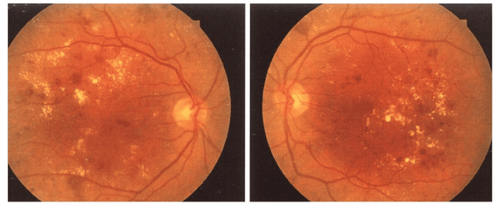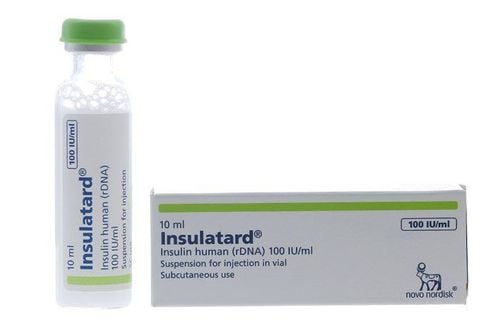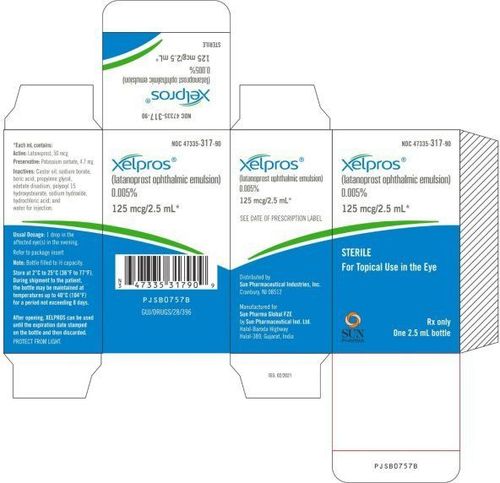This is an automatically translated article.
When blood sugar is not well controlled, it can lead to a number of health consequences. In many cases, high blood sugar can seriously affect vision and cause eye problems, such as blurred vision, cataracts, glaucoma, or diabetic retinopathy.1. Overview of diabetes
Diabetes is a disease that is related to problems with the hormone insulin in the body. Normally, the pancreas (the organ behind the stomach) produces insulin to help the body store and use sugar and fats from the foods you consume in your daily diet. Diabetes occurs when the pancreas produces little or no insulin, or when your body does not respond appropriately to insulin. This condition is known as insulin resistance by experts.Diabetes currently has no definitive treatment, so it requires patients to manage and control their blood sugar well so as not to develop serious complications caused by the disease.
2. How does diabetes affect the eyes and vision?
You need to plan to see your ophthalmologist periodically during the year when you have diabetes. High blood sugar can lead to a number of serious diabetic eye problems including cataracts, blurred vision, retinopathy and glaucoma. In fact, diabetes is considered the main cause of blindness in adults between the ages of 20 and 74.Here are the 5 most common ways that diabetes can affect your eyes and vision force, including:

Tiểu đường ảnh hưởng nghiêm trọng đến thị lực
2.1. Diabetes blurs the eyes
You shouldn't be in a hurry to get a new pair of eyeglasses right away when you notice that your vision looks blurry, as this can be a minor problem due to blood sugar levels being too high for normal. The lens of your eye can swell and change your ability to see things around you.To improve and eliminate blurred vision, simply bring your blood sugar back into the normal range, equivalent to 70-130 milligrams per deciliter (mg/dL) before meals, and less than 180 mg/dL. dL 1-2 hours after a meal. It can take up to 3 months for your vision to fully return to normal.
Ideally, when experiencing sudden blurred vision, you should talk to your ophthalmologist, as this could be a symptom of a more serious problem. Because in addition to blurring diabetic eyes, dry eyes are also a common condition that patients need to be aware of.
2.2. Cataract status
The eye's natural inner lens allows your eye to see and focus on an image similar to a camera. When the lens of the eye is cloudy or blurred, it can lead to cataracts. Anyone is at risk, but people with diabetes seem to have a higher tendency to develop cataracts than others, and they may even experience complications more quickly. .When part of the lens is cloudy, your eyes will not be able to focus as they should and will prevent you from seeing the object in front of you. Common symptoms of cataracts often include blurred vision and glare. You will need surgery to remove the cataract. The doctor will replace the cloudy lens with an artificial lens.
2.3. Glaucoma
People with diabetes are more likely to develop glaucoma of various forms or types.When the fluid cannot drain out normally, pressure builds up inside the eye. This damages the nerves and blood vessels in the eye, and causes changes in vision.
One of the most common types of glaucoma is open-angle glaucoma, which is usually treated with medication. Medicines can help lower eye pressure, speed drainage, and reduce the amount of fluid your eyes make (aqueous). In general, open-angle glaucoma does not cause any symptoms until it is more advanced and your eyes have severe vision loss.
Some of the less common symptoms of glaucoma include:
Headache Blurred vision Eye pain Watery eyes Loss of vision Seeing halos Treatment for glaucoma usually includes medications and special eye drops. In addition, the doctor may also ask the patient to perform surgery and laser treatment to help reduce eye pressure.
In case you already have diabetes, you are also more likely to have another rare condition, called neovascular glaucoma. This causes new blood vessels to grow in the iris, the colored part of the eye. These new vessels block the normal outflow of fluid in the eye and lead to increased intraocular pressure.
The main treatment of neovascular glaucoma is to reverse the formation of new blood vessels. For this case, the doctor will use a laser to reduce the number of blood vessels at the back of the eye or inject anti-VEGF drugs, and combine some other measures to quickly lower eye pressure.
2.4. Diabetic retinopathy
The retina consists of a group of cells located at the back of the eye, responsible for receiving light and converting it into an image through signals that the optic nerve sends to the brain.When the small blood vessels in the retina are damaged, it can lead to diabetic retinopathy. This disease usually occurs when blood sugar levels are too high. If not detected and treated early, it can lead to blindness. The longer you have had diabetes, the higher your chances of developing diabetic retinopathy. The risk of disease will be reduced if you have good control of your blood sugar.
People with type 1 diabetes rarely develop the condition before puberty. It is also rare in older people unless they have had type 1 diabetes for at least 5 years. However, keeping your blood sugar under tight control with an insulin pump or injecting insulin several times a day will reduce your odds of developing diabetic retinopathy.
In the case of type 2 diabetes, you may notice some signs of eye problems when diagnosed. Therefore, to slow or prevent diabetic retinopathy, you should have good control of your blood sugar, cholesterol, and blood pressure levels. Not only will this help improve the health of your eyes, but it will also boost your overall health.

Võng mạc tiểu đường có thể dẫn đến mù lòa
2.5. Proliferative Diabetic Retinopathy
Proliferative diabetic retinopathy usually occurs when the cells at the back of the eye don't get enough oxygen and new blood vessels start to grow. These new vessels are usually very fragile, so they can bleed and lead to hemodynamics. This causes scar tissue and retinal detachment.If the retina is torn it can lead to irreversible vision loss. However, your doctor may recommend laser surgery to remove the abnormally growing blood vessels in the eye, helping to prevent blindness.
3. Importance of regular eye exams
You should have your eyes and overall health checked every year to help detect problems early when they are easy to treat. This will help prevent serious vision loss.If you are planning to become pregnant, you should also have an eye exam to avoid some possible health problems and should keep these visits throughout your pregnancy. In addition, if you notice any of the following eye symptoms, you should immediately notify your doctor for timely treatment, including:
Blurred vision Having black spots in vision Seeing flashing lights Seeing floating spots before vision In short, diabetes causes a lot of health consequences, in which the eyes are the most affected and serious part. Therefore, people with diabetes in addition to taking medication, maintaining a healthy diet also need to perform periodic health checks to have timely prevention.
Vinmec International General Hospital is a high-quality medical care address with a team of well-qualified and qualified doctors present in all different specialties. For patients with diabetes, during the examination, an endocrinologist will directly check and if necessary can combine with many different specialties to give the best treatment plan for diabetes. each patient case.
Currently Vinmec Times City International General Hospital is applying Pascal beam laser with many advantages. This is the most advanced retinal laser photocoagulation device in the world today, overcoming many disadvantages of today's common lasers. The laser effect time on the retinal tissues is very short, does not cause extensive burns around the laser area, so it helps to control the desired effect, causing less damage to the retina around the laser area. Besides, this is a safe method of treating the macular area. Moreover, this method causes no or very little pain, minimizing complications and side effects of the laser. Thanks to good medical quality, customers can rest assured about the results of treatment at the hospital.
Please dial HOTLINE for more information or register for an appointment HERE. Download MyVinmec app to make appointments faster and to manage your bookings easily.
Reference source: webmd.com












